The Downside of Microplastics in Canada’s Waterways
The Downside Of Microplastics In Canada’s Waterways
Microplastics in Canada’s waterways are bad for our wallets and magnify water quality inequities
“We throw away billions of dollars of plastics every year in the form of wrapping and single-use plastic." - Dr. Peter Ross
“We throw away billions of dollars of plastics every year in the form of wrapping and single-use plastic. It is a loss for the Canadian economy, and it is a negative for the Canadian environment,” explains Dr. Peter Ross, Senior Scientist and Marine Pollution Expert.
Single-use plastic products can break down and become microplastics in the environment.
Dr. Ross joined us from British Columbia’s Raincoast Conservation Foundation for an interview on microplastic pollution. He brings a unique perspective having crossed over into academic, government and private sector realms. His expertise ranges from microplastics to the many emerging ocean pollutants out there, including other chemical pollutants.
Microplastics are defined by their size
“There is no real romance in the scientific definition of microplastics. Scientists around the world have simply agreed that any plastic item smaller than 5 mm will now be referred to as a microplastic,” explains Dr. Ross. “It is a size-based definition.”
Microplastics in this size category can come from just about any plastic item. There are many different chemical combinations included under the umbrella of microplastics.
So many consumer and industrial products today are made from plastic. Over time, these products can break down into smaller and smaller pieces. Dr. Ross explains that they can originate as useful products, like fishing nets, polyester sweaters, rubber tires or a toy like LEGO®!
"...the more we look, the more we find." - Dr. Ross
“These little bits of plastic we find in the ocean come from just about all sources of plastic products, and the more we look the more we find,” says Dr. Ross.
Interesting microplastic patterns are found in our oceans, which reveal clues about the dominant microplastic sources
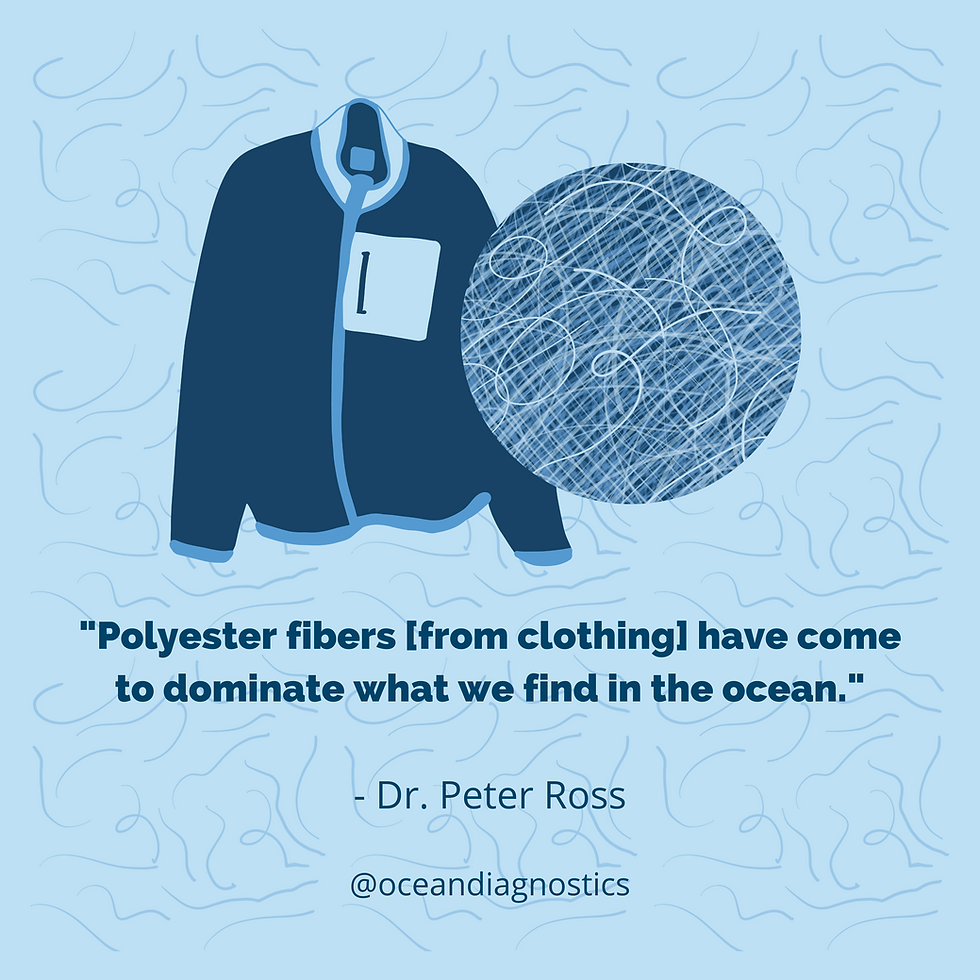
Dr. Ross explains, “we have found that the dominant type of [microplastics] are fibers 0.01 mm to 0.015 mm thick and 1 mm long and different colours.” These intriguing fibers suggest that clothing, wastewater and household pollution contribute to ocean microplastics.
“Polyester fibers dominate what we find in the ocean, and this underscores the connection to every home on the planet.” - Dr. Ross
“Polyester fibers dominate what we find in the ocean, and this underscores the connection to every home on the planet,” says Dr. Ross. Simply put, “they are not very useful in the environment.”
The textile industry can play a role in the creation of more sustainable clothing. Dr. Ross explains, “Typically, the clothing industry has been concerned with water use, pesticide use, [and other pollutants], but fiber that sheds from clothing, either from its lifetime of use or when it is washed, is a very important additional question...There is a good solution-oriented appetite out there, and there is a lot that can be done to reduce fiber loss from clothing.”
Microplastics may physically threaten creatures at the bottom of the food web
Society was drawn to the convenience of plastics around the 1950s. However, plastics soon emerged as a threat capable of entangling animals and blocking gastrointestinal tracts.
“We learned a lot in the 1970s and 1980s about the impacts of plastic items in the ocean...That is where a lot of the evidence of plastic impacts have come from.” - Dr. Ross
“We learned a lot in the 1970s and 1980s about the impacts of plastic items in the ocean when we saw sea turtles, albatross, seals and whales either tangled up in plastics or consuming them. That is where a lot of the evidence of plastic impacts have come from,” explains Dr. Ross.
Now that scientists examine smaller microplastics, the focus has shifted towards animals at the bottom of the food web.
Microplastics offer zero nutrition and do not serve any useful function for these smaller creatures’ health." - Dr. Ross
“[We are worried about] the small creatures that mistake microplastics or microfibers for food. Regrettably, microplastics offer zero nutrition and do not serve any useful function for these smaller creatures’ health,” he shares.
For example, microplastics have been found in small fish, crabs, shellfish and zooplankton, which include very important species that form the base of almost all oceanic food webs.
“We find microplastics in all of these ocean species. The real question is what does it mean for their health and for the health of the oceans? That remains really to be seen,” explains Dr. Ross. “The news points in the wrong direction, with more and more releases [of microplastics] every year.”
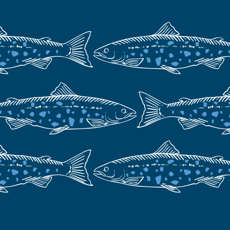
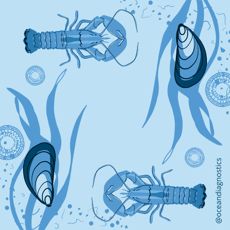

Microplastics pose two potential threats: chemical & structural
There are two concerns linked to the consumption of microplastics.
1. “Chemicals that are bound up in the plastics”
This includes chemicals such as hardening agents, softening agents, flame retardants, dyes, and other chemicals often called additives. All of these chemicals add to the function of the plastic product.
2. “Structural toxicity”
This includes items that could structurally impair good health, like pieces of plastics that block the gut of a small fish or a fiber that could become lodged in the intestine of a human.
“My concern is the later," says Dr. Ross. "The evidence suggests that mistaking plastics for food is more of a threat to good health than the chemical-associated toxicities, but at the same time, lots of science still needs to be done. There is still lots to do in the science world and also in the solutions world.”
It is not just about the small ocean creatures. Microplastic pollution from single-use plastic is also an issue for our wallets
"In the case of single-use plastics...it is estimated that around $120 billion dollars per year is thrown away" - Dr. Ross
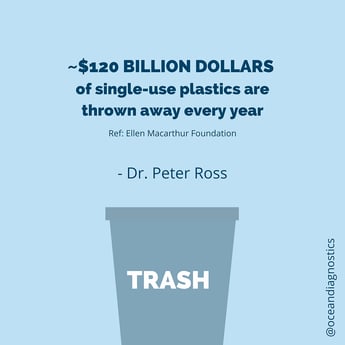
“Just in the case of single-use plastics, including straws, beverages, etc., it is estimated that around $120 billion dollars per year is thrown away (Ref: Ellen MacArthur Foundation).” Dr. Ross explains, “as a society, we have to figure out what we need plastics for and what we can do in an alternative space. There are lots of exciting innovations happening right now in Canada to reduce single-use plastic waste."
Impacts from this plastic and microplastic pollution are inequitably experienced in regions around the world, and Canada is no exception
About 80% of macroplastics, such as water bottles and bags, are released into the ocean from Southeast Asia, but some of this plastic waste comes from other countries like Canada. Canadian plastic is sent to countries where the infrastructure does not exist for recycling and reuse.
At home in Canada, microplastic pollution impacts water safety in Indigenous, remote and rural communities that may already have limited access to clean water.
“Even though Canada has 20% of the world’s fresh water and a relatively small population... we still have significant water quality issues across the board..." - Dr. Ross
“Even though Canada has 20% of the world’s fresh water and a relatively small population... we still have significant water quality issues across the board, from microplastics, to lead, to disinfectant by-products, to bacteria, and others as well,” observes Dr. Ross.
Location is important, as water quality issues vary by region, but knowing what pollutants are in your water supply is difficult.
Communities with water quality issues often look to bottled water for health and safety. But, as Dr. Ross says, "study after study has shown that tap water is safer... and a better bet than bottled water.” Bottled water essentially comes from the same water compartments as tap water and bottled water is subject to processes that may introduce contaminants.
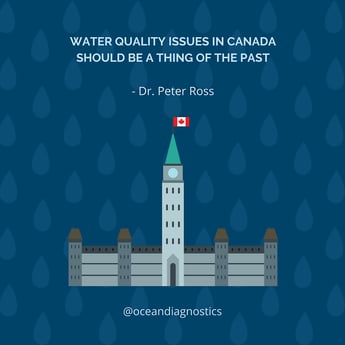
“This speaks to the need for Canada to adopt strong leadership in Ottawa that allows recycling systems and plastic-use economies to roll out on a national scale, in ways that do not unfairly victimize those communities. Leaders need to create a national framework that is fair and just for all Canadians and all Canadian communities,” states Dr. Ross.
He continues, “We do not think that Canadians or anyone in Canada should be worried about their water. That simply should be part of our past and not our present and future. We need to take responsibility for water quality and water safety, and we need to be proud of that resource that is so vital to all of us.”
Dr. Ross is up for the challenge and has embarked on a new ‘Healthy Waters’ initiative to create a short-list of contaminants of concern in different water compartments in British Columbia
Water compartments can be source water, drinking water, fish habitat, whale habitats and more. Dr. Ross will document pollutants across these different water compartments in British Columbia, in order to determine the pollutants that need to be focused on.
“We want to understand what the priority pollutants are so that we can track them from the mountain tops right down into the freshwater environments and then down into the ocean,” Dr. Ross notes, “and of course, we as humans will intercept that water along its journey.”
Dr. Ross looks forward to collaborating with many Indigenous communities on this new project; the details of which are still being confirmed.
When we know what the priority concerns are in different buckets of water, we “as community members, government agencies, or consumers, can step in and solve those problems at the source.”
(Learn more: Healthy Waters Program | Raincoast Conservation Foundation)
What can community members in Canada do to help fight microplastic pollution?
Ten years ago, the solution was to recycle, but despite all the efforts on this front, we still see only 9% of plastics in Canada recycled.
What does recycling really mean?
Recycling is not creating the same product over and over, Dr. Ross explains. Say you put a plastic pop bottle in your recycle bin, it will likely be shipped internationally and could come back as a polyester carpet, for example.
"We have to up the value of plastic." - Dr. Ross
“It is dead-end recycling. Recycling is very difficult and, unfortunately, it is not going to solve the problem [on its own],” he describes. “We have to up the value of plastic. We need to focus on the plastic that is important, rather than have a throwaway convenient world which contaminates our waterways.”
Reuse items, design items to be reused and create more compostables, these are the solutions.
“It is about teamwork” explains Dr. Ross. “This is not industries’ fault, not government's fault, not consumers’ fault. It is something we all own. We all have to work together and not feel as though one sector is targeted or threatened. We have to embrace the challenge and embrace the opportunity.”
"If there is one thing the average Canadian can do: Be a little bit more pushy, be a little bit more curious, be a little bit more energized..." - Dr. Ross
We should read and understand ingredient labels when we buy items, know what chemicals are in our plastic products. “If there is one thing the average Canadian can do: Be a little bit more pushy, be a little bit more curious, be a little bit more energized, because together we can do this; we can reduce plastic pollution; we can reduce the release of microplastic pollution...”
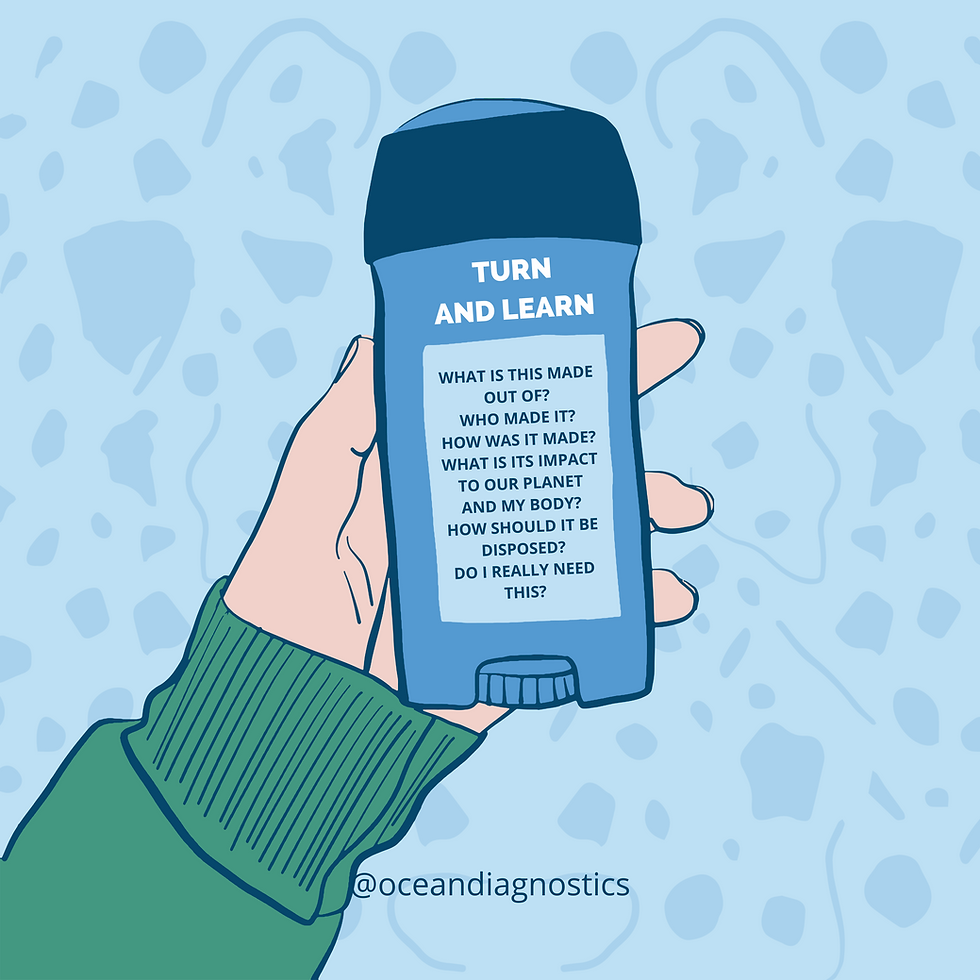
Learn more about microplastic pollution through our Community Science Campaign or head over to our Discovery Lab to learn for experts around Canada.
Subscribe to our newsletter and you won't miss a beat! We send weekly updates on microplastic news from experts in Canada.
Reference:
World Economic Forum, Ellen MacArthur Foundation and McKinsey & Company, The New Plastics Economy – Rethinking the future of plastics (2016, https://ellenmacarthurfoundation.org/publications).
Ocean Diagnostics Inc is an environmental impact company that develops technologies and laboratory capabilities to standardize microplastics data collection and analysis. The company works closely with academic and government partners to advance microplastic science. ODI has partnered with Environment and Climate Change Canada to share information on plastic pollution from Canadian plastic experts. Learn more here.
Follow #BeatPlasticPollution for the latest news.
